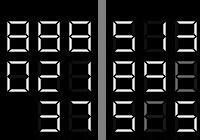Art Style: Code (Decode) (Nintendo DS) Review
By Adam Riley  23.04.2009
23.04.2009

Nintendo's bit Generations series was a collection of small, experimental projects for the Game Boy Advance devised mainly by Skip Ltd., the brains behind Chibi-Robo!, GiFTPiA and Captain Rainbow. Sadly the plans for releasing the range under the Anglocised name of 'Digistylish' or 'Digiluxe' (both were banded around at various events) were shelved due to the impending launch of the Nintendo DS stunting GBA software sales in the West. However, two of the GBA games were remade for WiiWare last year, whilst a brand new entry also appeared from the depths of Skip's office, under the new mantle of 'Art Style'. Clearly Nintendo still has big plans for these games that would likely be completely overlooked at retail since a whole slew have been announced for the DSi's download service, starting with Art Style: Code...
Code may well seem like a real chore for some mainly because of its core theme being based around mathematics. However, it really only boils down to simple arithmetic as players must form patterns of numbers that equate to a total of '10' either running from top-to-bottom or vice versa. The game works very much like standard puzzlers such as Tetris in that 'blocks' continuously fall onto the screen. The difference with Code is, though, that the DS is held on its side and single integers pour in from the left screen, heading towards the touch-screen with increasingly quicker speed. Players can tap on any number and drag it around the touch-screen, but each time one number is moved across from column-to-column or down from row-to-row, it will be flipped horizontally or vertically, in accordance with the direction it has been dragged. This means that, for instance, moving a '4' is not too simple as it would need to be moved across two places in order to be the right way round, with the same going for when dragged downwards. With a '2', though, rather than being completely useless when first turned over, it actually becomes a '5' when flipped either way, whilst a '6' becomes a '9' when turned upside down.
Therefore, some clever tactics can be employed to get numbers in the right position in as short a time as possible in order to start clearing large batches of digits. Should you have a a vertical column with '2', '1', '4' and '6', you could either tap on the '6', then the '4' to clear those two. Alternatively, switching the '4' and '6' around would provide you with a '9' and '1' next to each other, again giving a '10'. However, since it makes much more sense to clear as many numbers in one go to prevent both screens filling up and the game ending, swapping the '2' and '1' around would give '1', '5' and '4' - another '10' opportunity, this time removing three integers in one go. Another trick is to make the magic number using any of the red-coloured integers littered around the screen, ones that cannot be flipped in any direction. Including these as part of the final sum results in ALL the same numbers dotted around simply disappearing straight away, helping considerably.

Once you grasp the basic concept, remembering that to actually clear numbers you must tap on the first number in the sequence and then the last in a row or column, ensuring that both first and last numbers, plus the ones inbetween do actually add up to '10', then it all opens up wonderfully and gets the brain aching in no time at all. Code, along with the other titles in the Art Style series, does not focus on aesthetics at all, choosing very simplistic visuals and non-intrusive audio and instead simply delivering a frustratingly addictive package that will keep puzzle fans more than happy, as well as those that like to boast how they can do quick arithmetic with ease.
The main state of play described above is what players will find in three of the modes: Target (where a set amount of numbers need to be removed, with each new level throwing in an extra number - so earlier stages only include 1s, 2s, 3s and so on, yet later stages have 7s, 8s and 9s as well as even 0!), Endless (where play continues for as long as is possible) and Versus (yourself against anyone else, even non-DSi owners thanks to wireless transfer - with any line being cleared on one screen causing more to pile up on the opponent's). There is a fourth mode thrown in for good measure, though, and making this a must own DSiWare launch title: Puzzle. There are twenty-seven set puzzles on offer, and in each one the player must remove every single digit on-screen using the lowest possible number of flips. These will definitely drive many people crazy, and yet the majority will return time and time again to have another crack of the whip. Skip has definitely hit the jackpot with this little gem and it could well be the best 500 Points you will ever spend on DSiWare...

Cubed3 Rating
Exceptional - Gold Award

Sitting down and reading about a puzzle game based around arithmetic may put some people off, but after giving this even just a short try will convert people instantly, forcing them to flex their brains more than they could imagine and proving to be much more fun that Brain Training. Skip has delivered yet another Grade-A Art Style game...
Comments
Comments are currently disabled

 Sign In
Sign In Game Details
Game Details
 Out now
Out now  Out now
Out now  Out now
Out now  Out now
Out now  Subscribe to this topic
Subscribe to this topic Features
Features





 Top
Top

